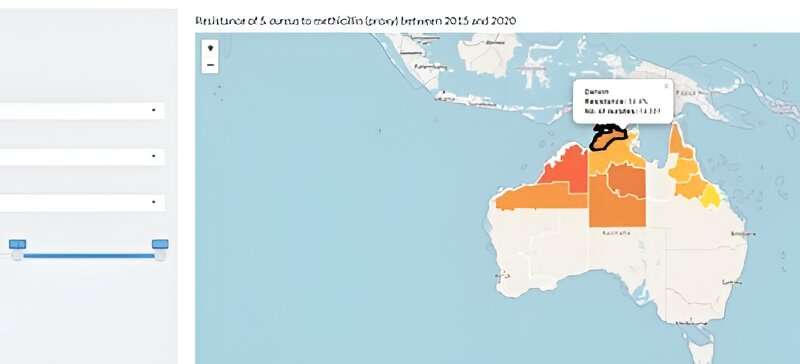The digital technology helping clinicians and researchers tackle antimicrobial resistance

Australia is a diverse country.
Deep-fried potato disks are scallops in Queensland but potato cakes in Victoria. Depending on where you live, you put on your "cossie," "swimmers," "togs," or "bathers" to go swimming. More importantly, is Wednesday night at your local RSL club chicken "parma" night or chicken "parmi" night?
Not all regional differences are trivial. Factors like population density, access to health care, and availability of resources vary greatly across the country. This means that health crises like antimicrobial resistance (AMR) impact every part of Australia differently.
AMR arises as bacteria and other pathogens evolve to become resistant to the drugs we use to target them. Unless we can minimize the spread of AMR, currently treatable infections will become life-threatening once more.
There is no "one size fits all" solution to the problem. That's where HOTspots, a CSIRO-developed AMR surveillance and education program, comes in.
The digital HOTspots platform collects and displays region-specific data on antimicrobial resistance.
The rise of antimicrobial resistance (AMR)
Why is the rise of AMR an issue when plenty of our antibiotics still work? Unfortunately, currently effective antibiotics might not work in the future.
Microorganisms are experts at coming up with ways to resist treatments. New species of resistant pathogens are always emerging, helped by bacteria transferring resistance genes between themselves. It's difficult to treat infections of resistant bacteria, so resistant pathogens can spread rapidly through populations.
More and more resistant pathogens, or "superbugs," are emerging due to the overuse and misuse of antimicrobials.
If the rise of AMR goes unchecked, currently treatable infections like tonsilitis and urinary tract infections will become deadly once again.
The right drug for the right bug
AMR is a major issue nationally and globally. But as Teresa Wozniak, co-founder of HOTspots and leader of CSIRO's Digital Solutions for AMR (DS4AMR) team, explains, not all populations are affected equally.
"The burden of AMR is highest in regional and remote areas. Yet, current national AMR surveillance activities don't capture these populations," she said.
That's what motivated Teresa to develop HOTspots.
The program combines data from hundreds of sources to monitor AMR across regions of northern Australia. MOre than 200 health care services in Western Australia, Queensland, and the Northern Territory currently supply data to the HOTspots program.
Artificial intelligence methods synthesize this clinical data with antimicrobial susceptibility testing data to produce region-specific, accurate, and up-to-date information on AMR. An interactive data visualization platform displays the information through maps and plots, offering insight into AMR behavior and trends over time.
Clinicians can readily access this data at the point of care. Bhavini Patel is Executive Director Medicine Management at NT Health. She says this helps clinicians choose the right drug for the right bug.
"At the moment, if you go see your doctor about an infection, they have no clear way of knowing what the right antibiotic is going to be based on local resistance patterns," Bhavini said.
"The HOTspots platform can provide information on infections and treatment in a region over the previous twelve months. Clinicians can use this data to choose the most suitable drug," she said.
Researchers also have access to the rich datasets generated by the program. The HOTspots team are collaborating with the Global Research on AntiMicrobial resistance (GRAM) program and other academic partners to monitor the impact of AMR nationally and globally. That's hot!
Adding fuel to the fire (of antimicrobial resistance)
The program already has over 200 collaborators, but our researchers aren't stopping there. They know that the battle against antimicrobial resistant pathogens has only just begun.
The team is continually updating the HOTspots program and bringing new collaborators on board. Teresa says that the next step is expanding the program geographically. The goal is to create an Australia-wide antimicrobial resistance atlas.
But humans aren't the only ones affected by AMR. What about the flora and fauna that we live alongside?
"We need to recognize that resistant bacteria coexist in an ecosystem—humans, animals and the environment all interact. You can't take one out of the equation," Teresa said.
Teresa's team want to expand the HOTspots program beyond human antimicrobial resistance. This could look like monitoring the spread of AMR in animal populations and investigating the movement of resistant pathogens in the environment.
As the fight against antimicrobial resistance heats up, our researchers are leading the way with innovative digital solutions.
Provided by CSIRO